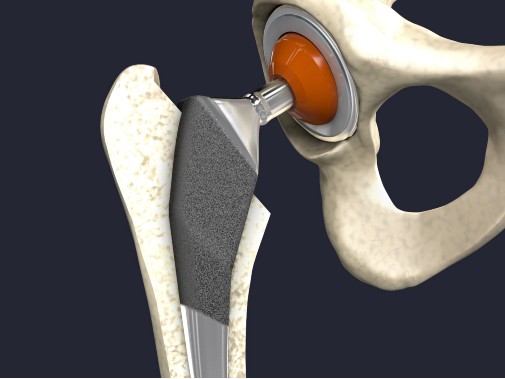Sugar could help repair artificial human joints
Posted on 24 November 2021
 Researchers hope the coating could eventually be used in medical implants to extend the life-span of artificial joints.
Researchers hope the coating could eventually be used in medical implants to extend the life-span of artificial joints.
An international team of scientists, including from York and Durham universities and Tsinghua University, China, has developed the technique for easily repairing low-friction surfaces.
Taking their inspiration from the way cartilage works to lubricate joints in humans, the team has found that rings of sugar can help a polymer latch on to surfaces and repair damage.
Publishing their findings in the journal Chem, they say their discovery could eventually be used in medical implants to extend the life-span of artificial joints.
Damaged
They hope the coating could also eventually be used to reduce friction-caused energy waste in mechanical systems, making them more efficient.
While cartilage can be restored by human bodies if it becomes damaged, artificial surfaces are not normally repaired so easily.
The research team found that if the polymer coating they have created is rubbed from a surface during use then a sugar ring in its structure allows it to reattach easily.
The coating created by the research team then mimics the way cartilage works to lubricate human joints.
Protecting
Cartilage uses water to make a slick surface that minimises wear and tear. In the same way, the new coatings coax a layer of water to the surface, making it slippery and protecting the surfaces as they are knocked or rubbed.
Research co-author Dr Alyssa-Jennifer Avestro, a Dorothy Hodgkin Research Fellow from the Department of Chemistry at the University of York said: “This is dynamic yet selective chemistry, which looks like it could be an effective way to undo the negative effects of mechanical wear on joints and other surfaces.
“If our protective coating layer is worn off, it is restored again without needing our intervention, thanks to targeted molecular recognition.
“This collaboration sets up exciting momentum for our Molecular Materials Research Group to deliver upon our University’s Research Theme strategies supporting Technologies of the Future for healthcare and energy."
Repaired
Senior author Dr Paul McGonigal, Associate Professor from Durham University said: “Hip and knee joints in our bodies stand up to decades of wear and tear thanks to the cartilage being repaired and replaced constantly. We have made materials that work in a similar way, but that are compatible with artificial joints.
“The components of our coatings are biocompatible, which makes them exciting prospects for use in medicine.
“We could also imagine developing a range of these materials that work in very different environments. Avoiding and repairing the damage caused by friction is equally important to ensure that cars and other machinery last for a long time.”
The researchers added that for now this type of repair requires more polymer coating to be dissolved in the water surrounding a surface, but they believe it will not be long until the coatings are improved to avoid the need for this extra material to be present.
The research was funded by the Engineering and Physical Sciences Research Council, the Royal Society, and Global Challenges Research Fund, the National Natural Science Foundation of China, National Key Research and Development Program of China, Precision Medicine Foundation, Tsinghua University, China, and Capital’s Funds for Health Improvement and Research, China.
Explore more news

Climate change set to take over as key driver of biodiversity loss by 2050, experts warn
Thursday 25 April 2024

Conservation actions are effective at halting and reversing biodiversity loss, study reveals
Thursday 25 April 2024

More than a quarter of people with Covid infection develop Long Covid, new research reveals
Thursday 25 April 2024
.jpg)
University of York awarded £1.1 million to lead the first stage of UK’s first comprehensive study on devolution and social security
Thursday 25 April 2024

More hybrid and nature-based solutions are urgently need to protect coastal communities from climate change
Wednesday 24 April 2024
